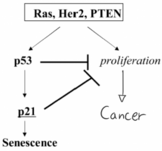38. Senescence
The average cell will proliferate and divide happily and without problem, however eventually the telomers on the end of the chromosomes will be so short that the cell cannot divide anymore without damaging the genome. At this point, the cell will enter a senescent (aged) state where they will no longer divide and eventually die.
Not only telomer shortening can cause cells to become senescent. DNA damage, oxidative stress, oncogene activation or some other problem with the chromosomes will also cause the cell to enter senescence.

The cell enters this stage by overactivation of a protein called p16, which is a CDK inhibitor. When p16 is overactivated, the cell cycle of the cell stops. This is a defense-mechanism against tumor formation, because if the cell continued to replicate even when there is something wrong with the DNA or the DNA would be damaged during replication, the cell could become cancerous.
Because p16 works to prevent cells from becoming cancerous, it’s a tumor suppressor protein. If p16 should be defect or inactivated, the cell could become cancerous.

Other tumor suppressors are also involved in this process. Ras, Her2 and PTEN are all oncogenes or tumor suppressors. If one of them are mutated and cancerogenous, the tumor suppressor protein p53 will step in and inhibit CDK and thereby the cell cycle and proliferation. If the p53 protein is defective or mutated, there will be nothing to stop the cell from becoming cancerous.
Senescent cells
Senescent cells do not replicate. The differences between senescent cells and normal cells is shown in the table below.
| Phenomenon | Replicative cell | Senescent cell (non-replicative) |
|---|---|---|
| Telomer length | Decreasing | Constant |
| Number of nuclear mutations | Many, increasing | Fewer, constant |
| Number of mutant mitochondria | Few | High, increasing |
| Deformed proteins | Few | Many, increasing |
| Lipofuscin | Few | Many |
| Protein degradation | Intensive | Slow |
| Antioxidant capacity | High | Low |
Sirtuins
A protein type called sirtuins, known as SIRT1, SIRT2 and so on. They are all protein deacetylases, so they remove acetyl-groups from proteins. When activated, they mediate many beneficial functions in the cell, like repairing DNA, stress resistance and genomic stability.
Notably, SIRT1 activates FOXO transcription factors.
